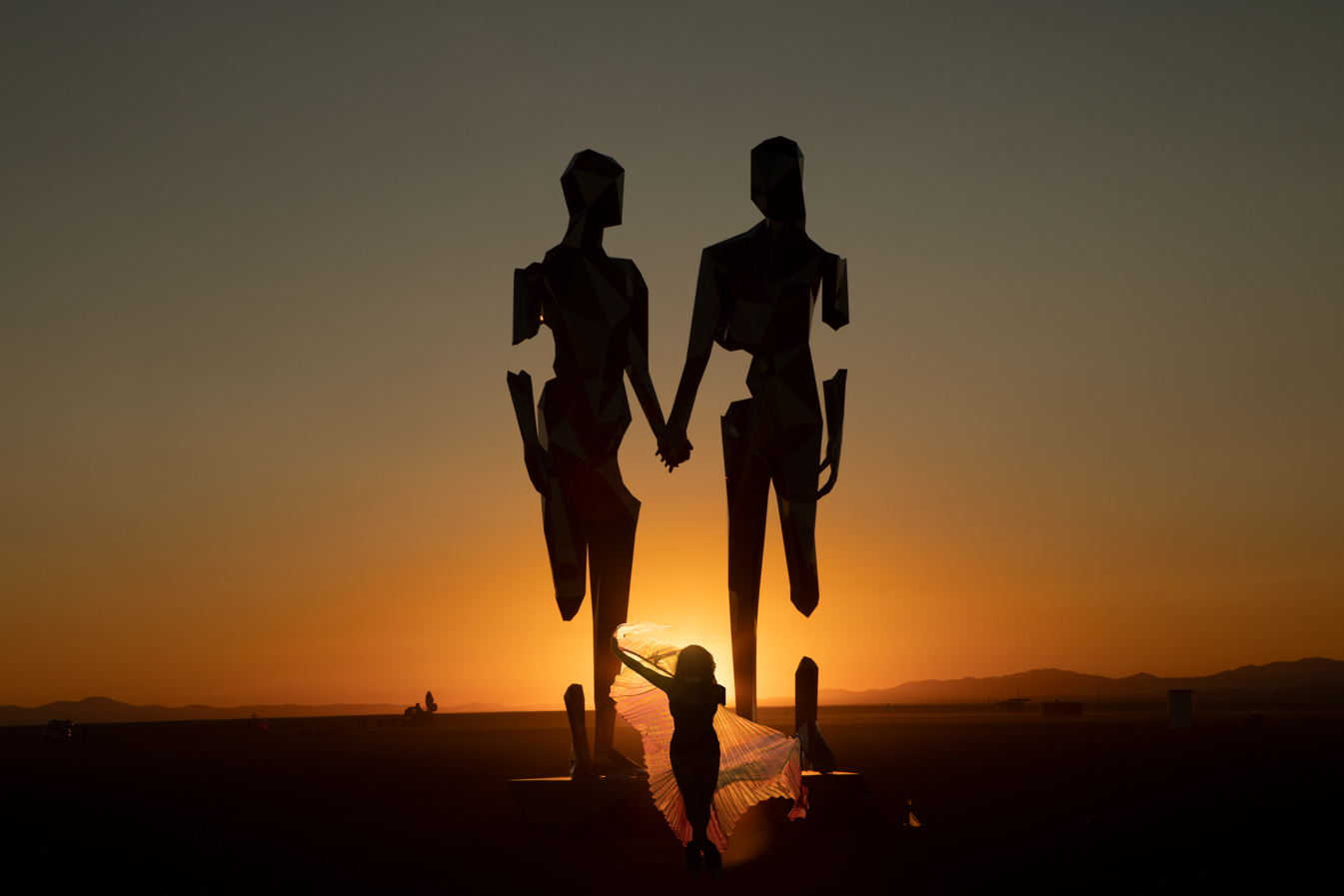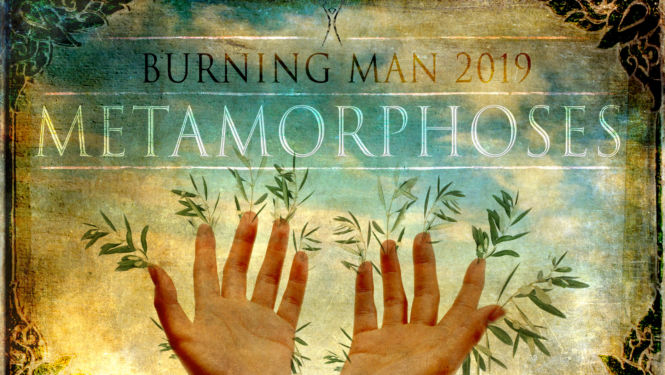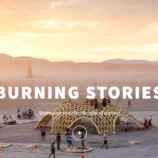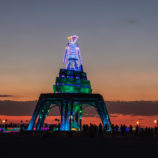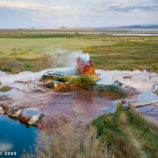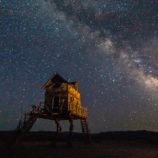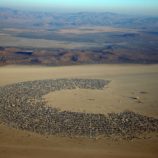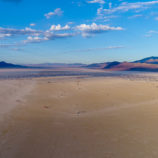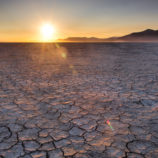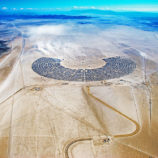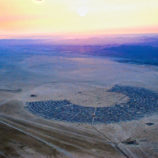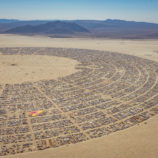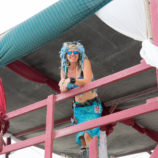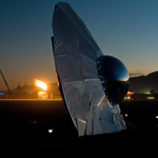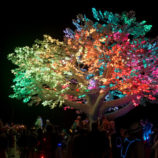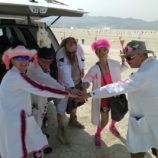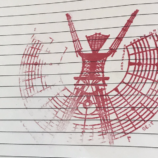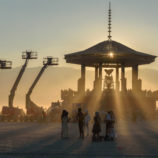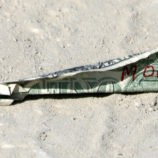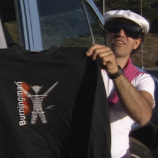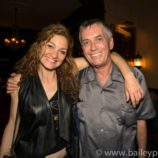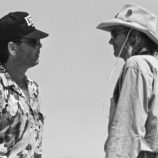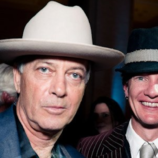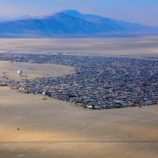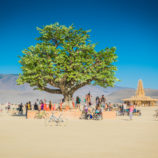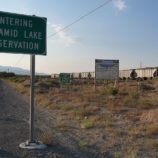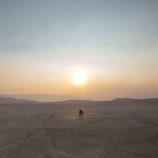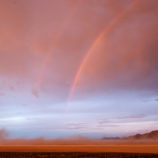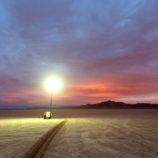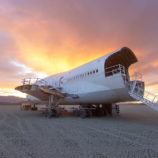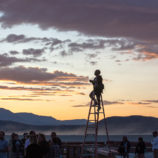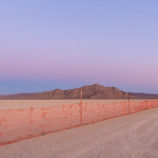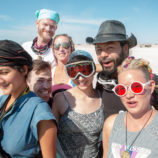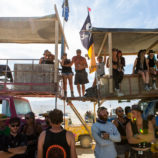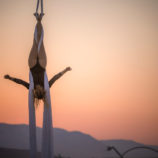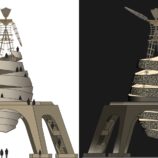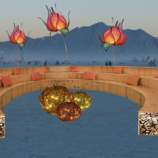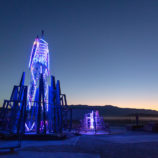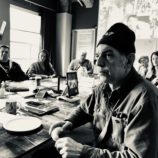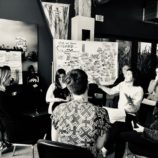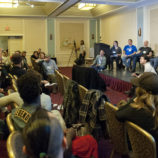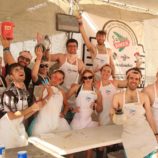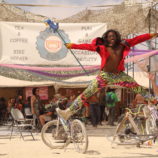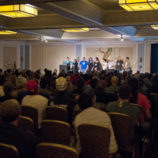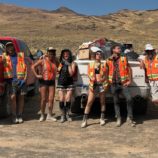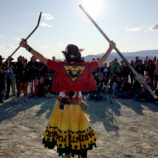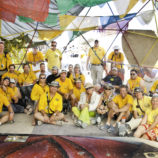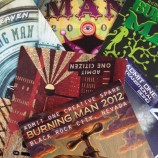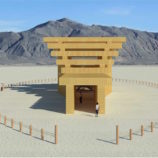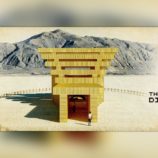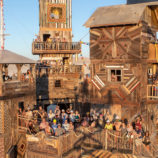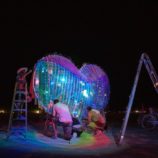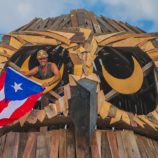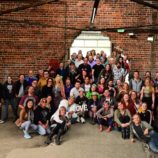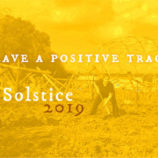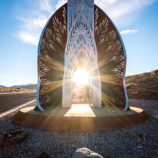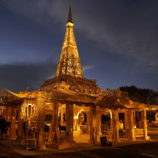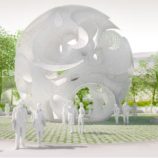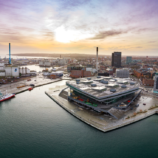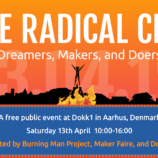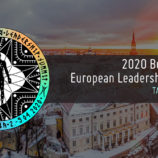The AfterBurn is our annual look back at the past year in Burning Man history — its ups, its downs, and its get-back-up-agains. Burning Man Project, the official name of the nonprofit Burning Man organization, is operated and supported by thousands of people who take responsibility for making Burning Man happen in the Black Rock Desert and around the world. The AfterBurn Report highlights what our various departments do, why they do it, what changes occur year to year, our successes and failures, and our vision for the future.
Browse past years’ AfterBurns here.
We also publish an Annual Report each year about our overall vision, impact, and health as a nonprofit, including a snapshot of our finances.
Burning Man 2019: Metamorphoses
2019 heralded some major metamorphoses for Black Rock City and the worldwide culture it birthed. Burning Man Project CEO Marian Goodell started the year by sounding the clarion call for change, and highlighting efforts to address the erosion of key Principles such as Decommodification, Radical Self-reliance and Participation in our desert home.
These efforts included calls for community help to stop the creep of Instagrammer culture, and the promotion of products on playa: from the big and splashy, to the smaller festival-wear business brigade. These communications worked hand in hand with the third year of the cross-departmental initiative Project Citizenship, which focused on Decommodification, Radical Inclusion and exclusivity, and Greening your Burn.
We supported these Cultural Course Correcting efforts by making changes to ticketing; tightening the Outside Services Program; and issuing warnings to camps commodifying the Black Rock City experience or being exclusive to participants not camping with them.
Theme camps were also the focus of one of the biggest projects this year, Cultural Direction Setting. Guided by a vision group of community members and Burning Man Project staff, the project turned extensive community consultation into a Vision for Residential Black Rock City. The year was bookended with the launch of the project’s second phase, which is working on solutions for implementing the Cultural Vision.
This year, Black Rock City rose to one of its greatest challenges and illustrated the collective power of our community when the Bureau of Land Management released its draft Environmental Impact Statement (EIS) for our new 10-year event permit. An outpouring of community support and substantive comments helped ensure we did not see dumpsters, private security and concrete barriers in Black Rock City.
Burning Man Project also rose to the global challenge we all face around climate change. We took the first steps towards transforming our environmental impact by releasing the 2030 Environmental Sustainability Roadmap.
Meanwhile, we marked the one year passing of Burning Man Founder Larry Harvey by calling on our global community to Leave a Positive Trace on the solstice, and by co-organizing a Permaculture Action Day at Hoover Elementary School in West Oakland.
On playa, it was a year of ch-ch-changes too. The art theme Metamorphoses drew a record number of placed artworks (415), and a record number of theme camps (1,545) were placed.
With Larry no longer designing the Man Base, the Art Department collaborated with community artists to build the 2019 Man Pavilion, which was designed by Yelena Filipchuk and Serge Beaulieu, and supported 26 aerial performances. Community artists also designed civic plazas on the 9 o’clock, 12 o’clock and 3 o’clock sides of the Man, where participants could connect.
Kerry Smith Cassidy created E Pluribus Unum: Out of One, Many with its circular seating and LED flowers; Benjamin Rowe created Small Community Shelters, which had delightful moments of canopy and shade; and the Man Base Crew created Man Pavilion Cafes, a circle of European-inspired cafes. Out in deep playa, Geordie Van Der Bosch and his crew also built the Japanese Torii-gate inspired Temple of Direction.
Despite tougher test standards and significant post-event weather setbacks, the Black Rock City site passed the post-event BLM inspection. We also had the greenest MOOP Map to date — testament to the incredible work of the entire Black Rock City community and to the Playa Restoration Team that stepped up to ensure we left no trace.
Beyond the playa, Burners Without Borders focused on community resilience building by distributing around $40,000 microgrants to projects around the world; Civic Arts helped place more Burning Man art in urban spaces than ever before; and Global Art Grants funded a total of $100,000 to 17 projects and programs across 11 countries.
Fly Ranch also continued to develop as an incubator space for community, collaboration and innovation, and Black Rock City drew interest from urban planners and city leaders about its own ability to incubate participatory citizens and co-created cities. Another delegation of US Mayors visited BRC this year; our Speakers Bureau received dozens of requests to speak about building Radical Cities; and 2018 Economics Nobel Prize Winner Paul Romer visited BRC for the first time and declared: “It’s just like every other city, except in this other way, it’s like no city ever.”
Top photo: “Broken But Together” by Michael Benisty (Photo by Eleanor Preger)
Table of Contents
For complete descriptions of the various Black Rock City teams, visit the Teams page.
1. Burning Man Project Staff & Operations
Business Culture
Autumn Winston writes:
Burning Man Project has worked with the Esalen Institute in Big Sur, California since 2015 to help one another create space for transformational experiences that lead to positive social change.
In 2019, Burning Man Project produced a 130-person convening at the Esalen Institute that focused on: The Principles of Inclusive Stakeholding and the Burning Man Project — Dr. Joon Yun; Creative Communities and Placemaking — John Marx, Debi von Huene, and Maya Zuckerman; Radical Collective Impact for Catalytic Neighborhood Development — Neil Takemoto, Marlon Williams and Monika Proffitt; Democracy: are you a spectator? — Matthew Kwatinetz, Rosie von Lila, Jamie Davies and Mike Zuckerman; and Creative Catalyst, Collaborative Workshop — Dana Albany.
This was the second year Burning Man Project held an Esalen convening that was open to the public. Through this event, we continue to further Burning Man Project’s mission of taking the culture out into the world, and to change the idea of being a Burner from someone who has only been to the desert event, to someone who embodies a set of values in day-to-day life. Many of the Esalen participants have never been to Black Rock City or any other Regional Event, and continue to put their time and effort into the health of the culture.
Next year, we plan to publish Esalen registration earlier in the year to allow for planning, and to ensure there is momentum from other gatherings, including Burners Without Borders summits and Fly Ranch gatherings.
We continue to see the power of networking the networks through convenings such as Esalen, and the potential of our community to create positive, impactful, and lasting change in the world.
Education
Stuart Mangrum writes:
In 2019, we launched our Burning Man history course called “Burning Man Then and Now.” This online course was developed to give learners an understanding of what Burning Man is, where it came from, and how it has evolved over the years — from a happening on a city beach to a global cultural movement. This content is useful to anyone in our community who’s in an acculturative or ambassadorial role — which is pretty much everyone — and has been well-received. Now the challenge is making it more accessible to more people who want this knowledge.
The Education department served a variety of training and education needs this year, including supporting multiple departments in creating trainings for their teams. Those departments include the ARTery, the Regionals team, Box Office, and the Fire Arts Safety Team. We also successfully supported the Volunteerism team in creating their Volunteer Leadership Training, which has been well-regarded by Volunteer leaders that have taken the training.
We also supported a variety of educational events such as the Theme Camp Symposium, the Newbie Orientation and Volunteer Faire, the European Leadership Summit, various staff meetings and trainings (The Ways meetings and the Staff Retreat), the BRC Ops Summit, and more. Additionally, we expanded some of our Burning Man Leadership Development Curriculum, which was created in 2018, to some of our BRC volunteer leaders at a Volunteer Leadership Retreat at Fly Ranch.
We also supported the all-volunteer group of scholars and the Burning Stories project, which launched in 2018. The project has been gathering stories from participants on their experiences with Burning Man and conducting ethnographic analyses. Based out of Aalto University in Finland, and building on the 2018 academic conference at the University of Fribourg, the Burning Stories team has expanded to include scholars in multiple disciplines, including business and organizational theory. Burning Man Project supported the team with on-playa resources, publicity through our media channels, staff access, and office resources.
One of the things we are working on for 2020 is creating an online learning platform that is accessible to more Black Rock City departments and the entire global Burning Man community in the future. We have been building the foundation for this global online platform over the last few years, and will continue to move towards this goal in 2020. A launch is slated for 2021. With this platform, we aim to support the Network of Networks organizational goal, helping our global community share their knowledge.
From the Journal
Finance
Doug Robertson writes:
Finance and Accounting had a busy year processing many transactions, preparing the organizations tax return, undertaking the Audit and handling the day-to-day operations. We are proud to report that the Audit results were excellent. Burning Man Project’s 2018 990 (completed in 2019) is available here.
From the Journal
Fly Ranch
Matthew Sundquist writes:
At Fly Ranch in 2019, we had more than 70 public nature walks and 21 work weekends, which included a number of exciting collaborations. The Desert Research Institute organized a STEAM weekend and a geophysics campout. Art of Steam organized two banya-training weekends. Awful’s Gas and Snacks organized a weekend with Burners Without Borders, where they helped with a wetlands clean-up project at Pyramid Lake. Friends of the Black Rock High Rock organized two campouts. We also had a Boy Scout Troop out for a walk.
We have a minimum viable property now. So while everything is still quite manual, the property is starting to come together with art, infrastructure, power, programming, and revenue. If we continue building on what we have, we could have a fairly well-built project in 3-5 years.
Next year, we will put in more resilient infrastructure, have fewer weekends so we can do a good job and not be quite so exhausted, and build out more capacity for managing projects. We are also launching an exciting new partnership with the Land Art Generator Initiative to launch a multidisciplinary design challenge to create the foundational infrastructure of Fly Ranch.
From the Journal
Government Affairs
Emma Weisman writes:
2019 was a significant year for Government Affairs. With a huge outpouring of support from the entire Burning Man community, we finalized our 2019-2028 Environmental Impact Statement with the Bureau of Land Management.
We remain thankful for all the comments submitted and attendance at public meetings in support of the Black Rock City event. None of the most concerning mitigation measures proposed by the government were required in 2019, including dumpsters on the playa, private security checkpoints, and surrounding the event with concrete barriers.
BLM has now adopted an adaptive management approach towards Black Rock City, and we are working to ensure that our track record of success proves that these measures are not necessary for our future.
2019 was the first of 10 events under the new permit, and Black Rock City operations were exceptionally successful. Challenges were met with cooperation and collaboration. Participants paid attention to Burning Man Project’s messaging, and expressed appreciation for a clearer understanding of the issues. Both Burning Man Project and our partner agencies in Nevada observed improvements in driving safety, playa stewardship, and roadside trash.
We will collectively double our efforts in 2020 and the years ahead to ensure these trends keep moving in the right direction. We are particularly thankful for our working relationships with Nevada state agencies, Pershing and Washoe Counties, and the Pyramid Lake Paiute Tribe. Northern Nevada is a unique and special place, and we love being a part of the community.
From the Journal
Nevada Properties
Lisa Nash writes:
We are out at Black Rock Station in Gerlach prepping Burning Man Project’s properties for use, maintaining our fleet of vehicles, and keeping our properties and assets functioning. We start in March and wrap up by the end of November.
This year, we finally repaired the plumbing in the saloon. It was a huge endeavor and took years of investigation, planning and finally implementation, but it is now done. Nevada Properties teams (Ranch, AutoShop, Common Shop/Kitchen) continued to participate and partner with the Fly Ranch Team on their events in 2019. It was a nice change for the team members to work with other groups, and to participate in weekend events at Fly.
Despite being understaffed (it is getting harder and harder to find people able to come out for the long season), we kept all the properties functional and implemented a new repair tracking system
Looking to 2020, we plan to start our season earlier so we can adequately prepare facilities and provide working and living spaces for all Burning Man Project teams that need to use these facilities. We will also plan to begin our hiring process earlier to give people adequate lead time.
Improving the work/life balance for our managers and crews will continue to be a priority next year. Living 125 miles from the nearest sushi, one of the best things we do is find ways to keep it fun for our crews.
This year we had poker nights, Early Early Early Man, Late Late Man, Almost Too Late Man, Homecoming and bowling night in Fernley. We are a ragtag group that keeps coming back year after year, and the spirit everyone brings is incredible and makes it all worth it.
We will never again run our post-season on the ranch and in Gerlach into November. It was too exhausting and the weather is hard for people who have already been out there for seven to 10 months.
People & Operations
Lindsay Loeffler writes:
We have a new team motto: #neveralone. It speaks to both the way our team operates, and also the way we want the managers and crew to feel while they are working with a wide variety of teams. As in previous years on playa, our team worked in pairs. This year we experimented with a new style of meeting structure, where we met in the middle of each day to put our heads together to determine our path forward.
It’s also the third year we have had volunteers on our team. In 2019, 10 volunteers joined us in our operations, and each team member added a unique perspective to our work. We offered several different trainings over the course of the event that were met with positive feedback. We debuted a new training called “Escalation Training — It Can Get Better,” and also offered some fresh content in the favorite “Giving and Receiving Feedback Training.”
We plan to experiment with the rotation of our team’s schedule in 2020. We want to work with our volunteers to be able to give our whole team the opportunity to experience what Black Rock City has to offer at different times of the day and provide a more well-rounded and balanced experience.
Technology
CameraGirl writes:
The Internet we built to produce Black Rock City was better than ever, with Technology Support and Event Operations running smoothly. We enabled ROIP transmission (integration of VoIP technology in two-way radio) over Black Rock City Network. We also implemented a purchasing system for our DPW and Build teams, and moved our Internal Feedback System (Ember) to use a similar system to the one that participants use (FLIP).
We put PlayaEvents login behind Burner Profiles, saving participants the burden of managing extra login credentials and making it easier to log in. The number of submitted events rose to 5,281 this year, a 16 percent increase over 2018. We also revamped the Volunteer Questionnaire.
From the end of the 2018 Burn to December 31, 2019, our helpdesk ticketing software resolved 30,000 general inquiries and 2747 Lost & Found cases. During 2019, Ticket Support resolved 27,664 cases.
We reduced errors in credential processing for Rangers with an API, and survived a filemaker server upgrade.
Looking ahead, we need to migrate to a new help desk and self-service portal for help.burningman.org; implement a fresh approach to HELL Station operations support; continue Volunteerism system development and upgrades; and expand Learning Management System platforms and content.
We are also considering new tools and imagining new ways for members of the Burning Man community and beyond to more effectively connect, create, and collaborate year-round and around the world.
In the Journal
Volunteerism
Kristy Hilands and Kez Quin write:
This spring our Volunteerism department partnered with the Burning Man Project Education team to host Volunteer Leadership Training Retreats at Fly Ranch. Over the course of two weekends, more than 50 volunteer leaders from 35 different Black Rock City and Regional Network teams entered into dialogue and collaboration with each other to share learnings from their unique teams, and participate in collaborative leadership training taught by members of our Burning Man Project staff.
The volunteer leaders who attended came from far and wide, including: Seattle, Marathon, Los Angeles, Portland, Talent, Gerlach, Fallon, the San Francisco Bay Area, Fitchburg, Vancouver BC, Vermont, Denver, Reno, Boulder, Santa Cruz, Las Vegas, Phoenix and Joshua Tree CA.
The outcomes of these two weekends far exceeded our hopes and expectations. The volunteer leaders dove deeply into connection with each other and with us, tackling the curriculum with tenacity. Following the retreats, the leads have begun self-organizing a cross-team mentorship program, which will allow them to shadow each other as they carry out their roles in Black Rock City.
These pilot retreats symbolized the beginning of a Volunteer Leadership Network at Black Rock City. Our Volunteerism department will work hard over the coming years to support this network as it grows and evolves, and will continue creating opportunities for volunteer leaders across Burning Man to stay in dialogue with each other, co-learn and connect.
On the training front, we offered our “Introduction to Burning Man Volunteer Leadership” course to the Regional Network, Burners Without Borders, and Black Rock City volunteer leadership, and the response has been fantastic! So far, 126 individuals have completed the online training!
The Peer Support Program provides management guidance, conflict mediation, counseling and coaching services to the volunteer leadership of Black Rock City and beyond. In only our second year on playa, counselors spent twice as many total hours in session as last year, with over 54 hours spent in session over the 2.5 weeks on playa.
During that time, they led 40 active counseling sessions and met with 55 volunteers from 19 different teams. We learned that we will have to expand our team by 50% and our physical space by 100% in 2020 in order to accommodate the expected exponential growth as reports of positive experience reach more of our volunteer leadership.
From the Journal
2. Black Rock City Operations
Airport
HazMatt writes:
The Burning Man airport, designated 88NV, successfully served the aviation community again in 2019. This community is more complex and varied than many Burners realize — it includes general aviation, scenic flights, ultralight aircraft, skydiving, Medevac, as well as a charter air program (BxA). For a brief moment each year, 88NV is one of the busiest airports in Nevada.
The airport experienced some last-minute turnover this year that created some additional challenges. The airport team readily rose to the occasion, and successfully brought 88NV online then made it disappear without a trace. Additionally, new acculturation efforts for incoming participants were implemented successfully and widely appreciated.
88NV hosted over 3,700 flight operations during the 2019 season, including over 800 flights gifted to participants by Burner pilots. This works out to one takeoff or landing every 2–3 minutes between dawn and dusk every day for 13 days straight!
Arctica
Marcia Crosby writes:
Arctica continues to be one of the ‘coolest’ places to volunteer in Black Rock City. Year after year, the feedback received from volunteers is overwhelmingly positive, proving that leadership and operations are ‘Doing It Right!’
Operations continued to run smoothly due to high volunteer turnout, volunteer satisfaction, and smooth leadership transitions. Additionally, the roll-out of the new credit card payment option was welcomed by participants, with 10 percent of those purchasing ice at Arctica opting to pay with a credit card.
Pre-event, we experienced an unanticipated increase in ice demand, which resulted in longer-than-usual lines. We are exploring an expansion of capacity pre-event to address this increased demand and reduce the lines.
Burner Express Air & Bus
Audrey Whaling writes:
Burner Express Air
The Burner Express Air team really came together in 2019! We had a great core team that worked closely with Dusty Charter, Inc. for the second year in a row. Our team did an excellent job managing delays from outstation airports, and dealing with challenges such as poor weather, closed runways in Reno, and other hiccups.
Looking ahead, we want to develop the core staff team further, and build collaboration among all partnering entities. We are all living and working together, and have opportunities to create efficiencies and reduce workload for staff members.
Burner Express Bus
The team once again KILLED it and ran a smooth operation busing a total of 16,601 rides to and from Black Rock City! The team dealt with challenges like a closed highway for several hours on the biggest day of ingress, fires closing the highway mid week, whiteouts and some equipment failures. They operated flawlessly, and it was a joy to see them fly.
Looking ahead, we plan to keep killing it while also continuing to find ways to better support our kick-ass team and develop our volunteer roles. Our teams work super hard, let’s celebrate them!
Burning Man Information Radio (BMIR)
Kanizzle writes:
Once again we provided the denizens of BRC with all the news, traffic, weather, and info that their pretty little ear holes could handle, sandwiched by our silly, absurd (and sometimes verbose) announcers telling stories, pulling in people off the street to tell their stories, and of course selecting the finest choices of music the universe has to offer.
We started a new storytelling production that brought more voices and facets of Black Rock City to BMIR, and, in general, more goodwill to participants. This included adding a ‘Chief Storyteller’ position to the team, who recorded and shared little snippets of our community’s experiences on the air between music and information.
Our phone project was also pretty silly. We solicited phone numbers from Burners that wanted to be called from the playa during the event, on air and maybe not on air. Then we had a series of phones around our lounge and in our studio that were AI driven (custom software written by one of our team) to call a random number when picked up. It was the MOST fun watching random participants walk into our lounge and pick up a phone only to be connected with an unsuspecting person on the other end of the line, and the nonsense conversations that would happen were priceless.
On the back of one half of BMIR’s senior management team stepping down last year, we took the opportunity to review where we’ve been, where we’d like to go and the particular volunteers who could bring their own magic to station changes.
We made some major changes in the way BMIR operated this year, shuffling around almost a dozen people’s responsibilities. We couldn’t be more grateful to have such amazing staff members who treat each other as family, and who ensured we still ran as smooth as butter despite the changes.
For 2020, we plan not to set up our aforementioned phones until after setup, and we plan on being even MORE awesome on the air in 2020.
Census
Sonder writes:
Our team theme this year was “Making it work!” Our main volunteer transportation was sketchy at best, but we were able to come together as a team and run census for another successful year on (and off) playa.
We collected a total of 6,435 responses for this year’s Black Rock City Census via our online survey, with 95% of data entered on playa. The day of the Man burn, we were able to present preliminary results for 2019 on playa.
We also focused on protecting downtime by doing a much better job of assigning days off, and actually letting our leadership go to the event.
Looking ahead, we will also focus on clear role division and a back-up plan for when technology fails.
From the Journal
Center Camp Café
Marcia Crosby writes:
This year, the Cafe’s 1,700-volunteer family included Jerry James, the person who built the very first Man in 1986 and brought it down to Baker Beach with Larry Harvey. He applied his builder’s acumen to several Café projects and participated in the Speaker Series on our larger stage, sharing stories from the early days and answering audience questions on the evolution of the Black Rock City event.
Building on our 2018 switch to iPads as registers, the Café made the big move to introduce a credit card payment option. The community embraced this change, with around 10 percent of people using it.
Café is pursuing a goal of significant reduction in single-use cups in 2020 and beyond, which is closely aligned with Burning Man Project’s Environmental Sustainability Roadmap.
Communications
Dominique Debucquoy-Dodley writes:
The Comms team took the lead on the third year of Project Citizenship, a cross-departmental push to address some concerning behavior in Black Rock City. Our focus areas for the year were: 1) Exclusivity & Radical Inclusion 2) Decommodification and 3) Greening Your Burn.
As part of this flagship campaign, we launched the Project Citizenship Toolkit webpage, a one-stop resource for camp leaders and participants to see how they can help with the effort. We continued with an email push titled “From the Desk of Charlie Dolman,” with four emails focusing on our key messages sent to both Pre/Main Sale ticket buyers as well as DGS ticket buyers.
A large push was made to spread the word about the commodification and exploitation of Burning Man culture, with the launch of a Burning Man Journal series on Decommodification. A series about Diversity & Radical Inclusion in the global Burning Man community was also started, as well as a series called “Consider Your Impact” that addressed topics around Leaving No Trace and sustainability.
We supported the roll out of Burning Man Project’s 2030 Environmental Sustainability Roadmap, and the year was especially busy with supporting Burning Man Project’s Environmental Impact Statement process with Bureau of Land Management.
The Comms team supported the publishing of Burning Man Project CEO’s Cultural Course Correcting post, a rallying cry for our community and a piece that has become one of our most-read Journal pieces of all time. We also gave editorial support to the Cultural Direction Setting Project and the very large task of creating a Cultural Vision for Residential Black Rock City based on extensive community engagement.
Meanwhile, we helped Placement continue its conversation with theme camps about best practices and culture by supporting the launch of the Stories From the City Journal series, and by working together with the Documentation and Education teams to live stream sessions from the 2019 Theme Camp Symposium to make the content widely available.
On playa, the 2019 Tip Sheet (that everyone receives upon entering BRC) was once again reorganized, with the back side of the sheet serving as a one-stop-shop resources for when participants might need help in Black Rock City (medical, law enforcement, Zendo, etc).
For the second year, the Communications team supported a group of mayors associated with the US Conference of Mayors, who came to visit Black Rock City in 2019. Comms supported Nobel Prize-winning economist Paul Romer visiting BRC with NY Times reporter Emily Badger. Two pieces were published, A Nobel-Winning Economist Goes to Burning Man and When Reporting an Economics Article at Burning Man, Be Prepared for Things to Get Weird, which explored city planning, BRC history, and what cities can learn from Burning Man.
Comms also spent a large part of 2019 supporting the behind-the-scenes work to prepare for Burning Man Project’s new cultural convening, now scheduled for 2021.
Beyond the playa, the Speakers’ Bureau received 104 requests for long-form interviews or speaking engagements in 2019 — we participated in 52 — and we supported the publishing of several important books related to Burning Man: Caveat Magister’s “The Scene that Became Cities,” Neil Shister’s “Radical Ritual,” and Will Roger’s “Compass of the Ephemeral.”
2019 was also a big year for Burning Man art in the world, and the Comms teams supported the “No Spectators” exhibition’s travel to the Cincinnati Museum of Art and the Oakland Museum of California.
From the Journal
Department of Mutant Vehicles
Chef Juke writes:
This year we worked with a journalist from The Intersection podcast. The podcast enabled us to hear the DMV process from the perspective of a first-time mutant vehicle team, which provided some incredible feedback. It helped us to review our processes, and how they affect the people who apply to bring a mutant vehicle to Black Rock City.
In 2019, the Department of Mutant Vehicles (DMV) registered 632 mutant vehicles and 405 vehicles for disabled participants. The number of mutant vehicles is roughly the same as the prior two years, and is below our high of 650 in 2015. The number of vehicles for disabled participants increased by one vehicle from the previous year. This was less of an increase than the previous few years, when we were seeing an annual increase of 17 vehicles per year since 2015.
For 2020, we want to increase the size of the DMV Council to better share the load of year-round work and planning; create additional teams to assist DMV Council so we can delegate some of our work; and streamline the application and on-playa review and inspection processes so mutant vehicles do not need to wait so long in line each year.
From the Journal
Department of Public Works
ChAos writes:
All in all it was a pretty smooth year for the Department of Public Works (DPW) despite a hectic leadup to onsite operations, and concerns about the possibility of new directives tied to our 10-year permit. Once in the desert, we hit every major milestone. Deliverable requirements were up across the board, yet our teams met the needs head on by thinking outside the box and redesigning processes to improve efficiency.
Along with the ever-increasing demand on DPW operations comes a need to level up management that’s ready to lead our teams to glory. 2019 was no exception. We continued to develop new management layers to further distribute responsibilities of leadership, and expanded the duration of involvement for others. We relied more heavily on department managers in mission critical areas to dedicate time during the springtime, which helped immensely with planning and allowed managers to more seamlessly step into operational duties once on site.
DPW has spent a lot of time over the years building stuff. It was only a matter of time before we would need to start fixing some of that stuff. The combination of hard use and hard winters has finally started to catch up for many of our assets, so we put together a team to start repairing and maintaining more than 600 assets. After a six-month work season, we’ve only just begun to make a dent in the repair needs.
Significant progress was also made in dust abatement. Since 2017, DPW and the Gate department have been collaborating toward improvements to gate road planning, lane management and watering applications in an effort to decrease surface degradation and reduce the amount of dust blowing through Black Rock City. Our teams are really starting to gel, and the efforts showed along gate road, which remained in great condition, as well as a reduction in the accumulation of dunes in Black Rock City following strike.
We began launching strike operations earlier than ever before this year. Of all the things we do for Black Rock City, nothing comes close to the challenge of getting the entire infrastructure off the desert in just 10 days. As always, it worked out and we took a long weekend to recoup before kicking off three weeks of Playa Restoration.
From the Journal
Documentation Team
Michael Fasman writes:
We started mandatory office shifts in our Office Container (OC), which not only kept it open for participants who were interested in our team, but brought team volunteers closer together. Our team also attracted eight new members from France, Israel and Switzerland, bringing our total to 64.
Together, we captured images of theme camps in action, Burners building art and the city, volunteer teams at work, the V-Spot supporting volunteers, those ephemeral acts of kindness, gifting and community, and more. We uploaded 5,000 images to our digital assets management system.
We also undertook video projects, such as the Man Pavilion Build, LOVE Project: The ARTery and internal training videos for the Gate and Mutant Vehicle departments. Plus the Profiles In Dust team had a full roster of shoots, including interviews for the “Larry” series; interviews about Death Guild; “The Disappearing City,” a documentary on Leave No Trace and the Restoration Crew; and a new documentary on solar power for the Theme Camp Innovator series.
Our plans for next year include more video production, better defined assignments, and more photographers on playa during build week.
Earth Guardians
Karina O’Connor writes:
In the last few years, we have been expanding volunteer shifts for Leave No Trace outreach and resolution. As we increase our efforts, we have also widened our resource team; separated roles of volunteer onboarding, training and dispatch; and undertaken more cross training for several of our roles.
For our events this year, we set up daily themes to help focus our talks. Wednesday was “Solutions for the Planet Wednesday,” Thursday was “DIY Thursday,” and Friday was “Science Friday.”
We also had so many events that we had to divide them up into categories (e.g. Bike and Nature Tours, Sustainable Black Rock City, Native Voices, Black Rock National Conservation Area-focus on local, Inspiration and Solutions for the Planet, Parties and Gathering, and Training and Volunteer meetings). We had awesome interest and participation in our events this year and loved the highlights we got in the WhatWhereWhen guide!
We included more folks in social media and video production this year, and we did some great short videos.
This year, for the first time, we added volunteer and manager wellness events to our busy schedule. We organized two Sit Your Ass Down, Self-care Spa Breaks in our new camper meeting spot (the peach pit). We have found that it is easy for folks to be too busy with volunteering — adding a spa event really helped with team wellness and bonding!
Looking ahead, we want to continue cross training for the Leave No Trace outreach team and among Earth Guardian managers. We also want to involve more folks in promotion of events, the environmental stage, and day manager shifts, and we want to do more videos for each volunteer team.
Emergency Services Department
Kate Gonnella writes:
This year, a total of 750 staff and volunteers worked with the Emergency Services Department, and 3,917 participants were given free medical care on playa.
Our department has put significant effort into recognizing our volunteers for the great work they do, and into increasing the amount of communication we do with them. Our post-event survey reveals a really happy bunch (well, except for those few grumblers), with more positive feedback than we’ve ever received in the past.
Some of our key highlights this year included the best staffing and returning volunteer numbers ever! Is it because people love ESD? The Love Project video we created? We don’t know, but it made us happy!
We replaced all but two rental buildings with Office Containers and Living Containers, decreasing the carbon footprint created by hauling large buildings across the state to Black Rock City (now we bring them from the ranch). We also integrated the Fire vendor into the city operations by moving their engines into the city, creating housing for them, and feeding them with our crews.
In 2020, we want to improve interdepartmental logistics coordination when we move the Emergency Operations Center and the Joint Operations Center, the compound where BLM, Pershing Sheriff’s office, and ESD dispatch center our co-located.
Everywhere Pavilion
Josh Lease writes:
We have done a call out for art to display in the Everywhere Pavilion for three years now. In 2019, we hosted Illustration STATION by Rob Selvaggio, along with 11 other art pieces in the space.
Illustration STATION was an interactive piece that included large scrolls of paper with the ends concealed within an elaborate base and frame. Playing on ephemerality, it invited participants to draw on it, and every evening the paper would be rolled further along the scrolls, revealing fresh canvas for the next day. When people returned, the drawings would be gone, consumed by the art itself.
This piece became very popular. It was beautiful to see participants from all walks of life come into the Pavilion and express themselves on the paper, including a Bureau of Land Management law enforcement officer who stopped and drew an extraordinary figure. When done, he stuck around for a bit and other participants started asking him questions, which he did his best to answer. Art bridged the divide that some feel between BLM and participants, and it was beautiful to see.
One hundred twenty volunteers supported the Pavilion, which also hosted 17 public events and 20 performances.
2019 was the culmination of a three-year process to bring the Artery and Everywhere Pavilion together as cohesive teams operating in the same space. When the spaces merged, it was not without some problems. But through collaborative work and problem-solving, we found our groove.
Next year we will change the decor in the space. The past few years have featured the same concept, and next year it is time for a facelift.
Gate, Perimeter & Exodus
Tabitha Hewitt writes:
This year, the longest reported ingress wait time was three hours, with the majority of participants waiting two hours or less. Our department’s performance confirmed that if everything is going well — as far as good weather, safe road conditions, few white outs at the Gate, a healthy collaboration with law enforcement, participant consideration to arrival timing, and solid staffing numbers — GP&E can achieve reasonable wait times even during peak periods.
Improved communication throughout the year allowed the Black Rock City Operations Team to work better with local agencies in responding faster to issues on the roads, and to get key messaging out to all travelers very quickly.
Our team responded well to the challenges that came with implementing a new ticketing vendor, and were supported successfully by the Box Office Team in a way that allowed GP&E to keep traffic moving smoothly while ensuring we were all doing our job well. This year taught us a lot about how the bigger Black Rock City team, which we are all a part of, rises when challenged and becomes even more creative in our solutions.
The management team also focused on staff and volunteer mental health in 2019. We empowered our Personnel Supervisor to add an assistant supervisor and a number of volunteer team members to create a support space on playa. This space provided teammates with access to peer support, mediation, worker’s compensation claims, and information about other resources on playa.
The GP&E People team worked hand-in-hand with Burning Man Project’s People Operations and Peer Support teams, and were able to use them as a resource for advice and escalation. This allowed people to discuss issues that they otherwise might not feel comfortable sharing with a manager, because managers are often perceived to be too busy.
This opened up a huge amount of room for our Operations Managers to be able to respond more effectively to operational needs while also feeling that our crew had a safe place to express the needs that arise from living and working together on playa.
In 2020, we want to provide more data to the Technology department and collaborate with Box Office to better define the timing of hardware needs and locations for operational and camp areas. We also want to collaborate early and extensively to make the events operations software system Marcato work for everyone involved. We will work on the next iteration of the laminate system to perfect a process that has increasingly improved each year.
Greeters
Julie Starr writes:
2019 was an exceptional year for teamwork, both within Greeters and with our partners in other departments. Communal Effort and Participation were strong with our team as we strove to share the 10 Principles with all our beloved participants. As a direct result, the team had many opportunities for personal connections and new shared experiences.
This year, our beloved Uncle Ira spent his 20th Burn with us. He truly lives the spirit of what we do and gives his light to all that know him. In honor of this momentous occasion, we gifted him a flag from the Greeters Station with all our signatures on it. It was a wonderful evening where we were reminded of the importance of chosen family, and how fortunate we all are to have each other.
Our team goal for 2020 is to raise awareness of what we do and why it is so amazing: tell our story. We would also like to bring new people into the Greeter Family. There is always room for more.
Lamplighters
Cliff writes:
2019 affirmed that one of the oldest Burning Man projects continues to be one of the most dynamic. We have over 25 years of experience navigating the changing tides of Black Rock City, and we’ve kept ourselves busy with our prime directive of lighting our city without fail.
As Burning Man tackles the big issues of charting a community Cultural Course Correction, the Lamplighters will stay focused on our shared work and purpose, taking care of one another, acculturating our new family members, and providing a meaningful way for Black Rock Citizens to participate in their city.
In recent years Lamplighters has thrived with an influx of newbies, and in 2019 we continued the trend with about 50 percent of our 154 Lamplighter Village volunteers being new folks. We hit our stride with undertaking intentional year-round recruitment via eplaya and social media, coupled with copious orientation information for all of our villagers, veterans and newbies alike. However, we had three nights on playa when we weren’t able to cover all of our routes with volunteers, requiring minor changes to our lighting plans.
This year was also testament to our work preparing new members of our Lamplighter management team. We continue to provide leadership opportunities for motivated volunteers who stick with us.
2019 was noteworthy for our participation in a shared experience with Fragment, an Honorarium art project from France. We worked with them to create a sunrise ceremony at their installation that involved 50+ robed Lamplighters greeting the sun. It was a deeply meaningful ceremonial experience for both our teams. Another highlight of our Burn was once again working with Mobility Camp for one of our evening lightings.
In 2019 we continued our Lamplighter Community Art initiatives with an installation along Rod’s Ring Rd. We also had 12 large Lamplighter art pieces designed to attract volunteers to us, and 80+ painted wooden tiles created by our villagers on playa.
For 2020, our management team is looking beyond the happy hour recruitment parties on playa and exploring new avenues for attracting nightly volunteers. We are also looking at ways to welcome villagers with children.
Man Pavilion
Kimba Standridge writes:
This year we experimented with selecting a Man Pavilion from multiple community submissions, and then turning that concept art into a buildable structure with our internal resources. It was a huge success. The multiple submissions enabled us to select a beautiful and thematic Man Pavilion that many people rallied behind, and the construction design team worked well to turn that concept art into reality on the playa.
A relatively easy strike night meant the Pavilion stayed open later on Friday, and the crew had a less grueling schedule in the wee hours of Saturday. A well-coordinated clean-up effort between Man Pavilion team and Playa Restoration team also resulted in a significantly cleaner site than previous years, and the passing of the Bureau of Land Management inspection at that site.
Looking ahead, we want to focus on improving construction design version control for drawings and some process stuff, as well as better use of Google drive for document storage vs. Slack. We also want to ensure that night crews are following the same safety rules as during the day.
From the Journal
Media Mecca
Dominique Debucquoy-Dodley writes:
Once again, in an effort to push for quality over quantity, we focused our media project proposal review process on reducing the overall number of Black Rock City media projects. This allowed our Media Mecca volunteers to provide guidance on higher quality work, and several fantastic pieces came out of the 2019 event. This year, we received 260 applications to cover the event, and we accepted 141.
Placement
Level and Muppet write:
This year was a pivotal year for the Placement Team. We addressed an unexpected growth in the number of camps requesting placement, forcing us to re-examine Placement’s criteria, process, and resource allocation work.
Placement reviewed the most questionnaires ever submitted (1,718) and placed the most camps ever placed (1,545), which meant our team was busier than ever both pre-event and on playa. This increase represented an 18% growth in camps from 2018.
City blocks were fully placed between Esplanade through Icarus Street, and through Labyrinth along the main avenues of each sector. We doubled the size of the Flagging team, which was not sufficiently staffed in the past. They planted an estimated 22,000 survey flags in the playa this year.
Expanded block sizes helped with better frontage/interactivity between A and E streets. Narrowed blocks between J and L streets allowed for better usage of those blocks for open campers who generally wish to have street frontage, and less under-utilized space in the middle of those blocks.
New plazas in 4:30+7:30 were a hit, and we were successful in filling all nine of the plazas with art.
In July, we also released the Cultural Vision for Black Rock City. We launched Phase 2 of Cultural Direction Setting Project on playa, which aims to work on solutions for implementing the Cultural Vision. Over 80 people across various sectors of the Burning Man community are participating in Phase 2.
For 2020, we want to make changes to the Placement Criteria, Placement Process, and Directed Group Sale Ticket allocations, based on conversations taking place through Cultural Direction Setting.
We also want to make updates to the Placement section of the Burning Man Project website to better explain Placement Criteria and Process, and expand the Camp Survey Squad so that we can visit 100% of placed theme camps and villages on playa.
Placement will focus on better integration with the Department of Mutant Vehicles, Art Department, and Outside Services to address concerns about camps/individuals who continue to undermine the 10 Principles on playa and erode the cultural fabric of Black Rock City.
From the Journal
Playa & Highway Restoration
DA writes:
Playa Restoration
Pre-Resto MOOP sweeps start right after the Black Rock City event ends, and is a volunteer team comprised of all new recruits who want to join the Resto team! Some of the recruits signed up with Resto ahead of time, and some walked up and signed up on the spot during the event at MOOP Map Headquarters at 5:30 Esplanade.
This year’s new recruits, about 30 in total, were especially outstanding, and they covered a lot of territory while everyone else was still striking their camps, art projects, and staff infrastructure operations.
One of Resto’s great successes of 2019 was the creation of the Test Team, which replicates the methods of the Bureau of Land Management (BLM) Site Inspection. The team tested random and non-random areas of Black Rock City every day for eight hours a day. This gave Resto important data on the general cleanliness of the city, and let them know how close they were to their target.
Despite the tightening of testing standards as a result of the Environmental Impact Statement by the Bureau of Land Management, Playa Restoration proudly achieved an unprecedented near-perfect score on the BLM Site Inspection. Final results are still pending the publication of the final BLM Inspection Report.
Black Rock City also scored the greenest MOOP Map ever! None of this would have been possible without the Leave No Trace effort of the 80,000 citizens of Black Rock City.
For 2020, Playa Restoration will recruit new team members earlier in the year!
Highway Restoration
Due to safety concerns, the Highway Restoration crew normally begins cleanup operations along the roadways on Wednesday post-event, when Exodus traffic has subsided. However, the Highway Resto crew got a head start by launching a new reconnaissance and outreach mission from Sunday, September 1 of Event Week through Tuesday, September 3.
Highway Resto managers observed the impact of the event on the roads; met with trash collection vendors along the Pyramid Lake Paiute Reservation, and learned their practices; conferred with Pyramid Lake Paiute Tribe Lake Maintenance, and Tribal Police; and visited Leave Nevada Beautiful partners. Highway Resto documented their work via geotagged photos and notes into their GPS app, and dash-cam footage.
The reconnaissance effort provided the crew with a better understanding of the underlying issues contributing to roadside trash. The team implemented some in-the-field solutions, such as creating signage at Pyramid Lake, interacting with the public, gathering intel, and asking trash vendors along the highway to leave their area clean.
The Priority Cleanup Phase is when we do the brunt of the work dealing with the bits of roadway debris. Three vehicles with 12-15 crew members focused on the following roadways: 34 from Gerlach, Black Rock Desert, Fly Hot Springs, Black Rock Station; 447; and 446, specifically around Gerlach, Empire, Nixon, Pyramid Lake, and Wadsworth.
Cleanup Maintenance Phase 2 cleans up whatever road debris is dropping from highway motorists, event-related or not. Highway Resto’s goal is to make sure that the highways remain clean and beautiful for the duration of our operations.
Road debris was down 30% since 2017! This is attributed to outreach and communication efforts about Securing Your Load and the Leave Nevada Beautiful campaign on burningman.org, the radio, signage on Gate Road, and in the Greeters Packet at the Gate. There was a slight increase in abandoned trailers and vehicles in 2019. Nevada Department of Transportation was extremely helpful in assisting with this issue.
Next year, Highway Resto will collaborate further with local authorities to keep a close eye on all trash vending operations to ensure they are properly permitted with the Pyramid Lake Paiute Tribe and they leave no trace.
From the Journal
Playa Info
John Schultheis writes:
In Lost & Found at Playa Info, we deal with thousands of found items every year, and it is much easier to reunite people with their stuff if they have their name on it.
This year, we expounded the benefits of participants labeling their stuff via video, PSAs and “word of mouth.” We also designed and built a new Playatech Label Station, which was set up near Lost & Found, and stocked with a variety of ways to label items. It appeared to generate a lot of use, and we plan to expand it in the future.
We created a new binder of documentation for Setup and Breakdown. This included photos, descriptions and notes to help the teams be more organized and efficient.
This year we transitioned the Leadership of the Lost & Found and Ambassador Program to new people. The coordination of Lost & Found services transitioned to Sparkle Ann. Many thanks to Double Check for 10 years of service and creating this finely oiled Lost & Found machine. After many years of dedicated leadership by Special, the Ambassador Program was taken over by Mr. Kilt and the Ambassador Leads.
In 2019 we introduced our new viewing platform, a modular wooden structure that sits on top of our Breakroom Shipping Container. This allows our volunteers to safely watch the burns and enjoy the sights and sounds of the playa.
Going forward, we want to improve the remote connectivity through our “Pi-fi.” This allows volunteers and participants to use their Wifi-enabled devices to access local content such as the Lost and Found database, and other “digital services” we provide on the computer terminals at Playa Info. We also want to increase participant awareness of what digital services are available to them at Playa Info.
Rangers
Roslyn writes:
2019 Ranger operations were mellow, but high-tempo. Staffing was good overall. We trained approximately 1,112 people (Rangers, prospective Rangers, and auditors), and conducted 43 Ranger trainings across the U.S., Canada, the U.K., South Africa, and the Netherlands. Around 850 Rangers covered the 2019 event. Busy playa shifts were better staffed than in 2018, and even the high-tempo shifts were very smooth. Challenging things came up, because that’s the nature of Black Rock City, but people handled it.
Gerlach Patrol: Rangers continue to support the town of Gerlach by deploying teams there and working with the Washoe County Sheriff’s Office to encourage travelers to be respectful of the local townsfolk and their property.
At the request of The Gerlach K-12 School administration, Rangers monitored the campus and checked in with anyone seen on the school grounds. They also worked to prevent trespassing on private residences, and responded to calls from residents on a dedicated phone number distributed to the community. The Gerlach Patrol was a huge help handling traffic jams after two different incidents temporarily shut down Highways 34 and 447.
Burn operations: More Rangers worked the Man and Temple burns than in the past several years, demonstrating continued commitment to the goal of participant safety. Integration with the Burn Perimeter Support Group at the Ranger-supported burns was generally successful.
ESD dispatch co-location: We expanded on last year’s pilot program that stationed an experienced Ranger in the Emergency Services Dispatch Center to help coordinate between Ranger Shift Command, Emergency Services Department, Bureau of Land Management, and Pershing County Sheriff dispatchers. The goal was to decrease incident response time and improve coordination in complex, interdepartmental/interagency incidents. The pilot ran for 12 hours a day during the event in 2018, and this year we extended it to run 24 hours a day.
Sexual assault response: Pre-event, Rangers and Emergency Services Department worked closely with the Pershing County Sheriff’s Office to refine and clarify our procedures for handling cases of sexual violence and assault. It is our hope that establishing these relationships will result in closer alignment and cooperation when dealing with these incidents in the future.
Looking ahead, we need to improve calculations, coordination and safety checks around burn perimeters.
From the Journal
Recycle Camp
Spanky writes:
Aside from Crushing It™ with the aluminum can recycling, we just had a great time! It’s awesome when a team really comes together to work hard, make it all happen, and make everything feel seamless. Recycle Camp went up and came down in record time with returning volunteers, first-timers and even their kids!
A testament to our planning and our new kick ass volunteer coordinator, we had more walk-on and scheduled volunteers than ever before, giving more participants a chance to enjoy the Recycle Camp experience. We also saw more of our reusable mesh bags come back for another year, a great result for our pilot project that helps educate participants on how best to recycle on playa. We also upgraded several components of the Crushinator, our bicycle-powered can-crushing machine.
As usual, we donated the proceeds of our aluminum recycling to the local school system in Gerlach. This year we crushed cans from four 30-yard dumpsters and donated $2,741.
In our unrelenting quest to make Recycle Camp more awesome every year, we plan to upgrade our can-moving bins, convert more shade to Aluminet, and, of course, implement bigger, stronger magnets to attach things to our shipping containers! We’ll also need to adjust to having more participants bringing cans earlier in the week, as well as find a better way to train our new volunteers and handle shift changes better.
Temple Guardians
Cherub writes:
This year our leadership team was diverse and cohesive, and fewer people were working extensive hours. This enabled the team more time to decompress between shifts and make clearer decisions when the need arose.
Two key leaders stepped back in the run-up to the event. Thanks to their solid work over the years and the depth of our ranks, others were already trained to step into their places, and we had our best year ever organizationally.
We built on an already great base of training, and used the change of leadership as an opportunity to expand and include a key leader (Katrina) who stepped up magnificently. Our leadership managing burn perimeters also grew. Kahuna stepped up from being a leader within the Temple Guardians for burn perimeter, to being the trainer for all Temple Guardians and Burn Perimeter Safety Group at the event.
Temple Guardians find ourselves on a fine line separating holding space and policing space. This challenge often involves a mixture of design choices by builders, allowing Burners to be Burners while expressing themselves freely at the Temple, and providing a safe space for remains.
This year we focused on developing ourselves so we can address a safe experience at the Temple in a “safety-third” community. With the Temple design for 2019, we also learned that we must again address and adjust our ideas about memorial placement, safe heights, and how to manage that with love and compassion.
Looking ahead, we need to manage the issue of climbing at the Temple better, and we need to develop our leaders even more in 2020.
Ticketing
Nimbus writes:
2019 was a difficult year for ticketing. In late 2017 we embarked on an exhaustive search for a new ticketing technology partner. An interdisciplinary leadership team was assembled to participate in the evaluation and ultimate provider recommendation. The final stages of this process took longer than planned and wound up coinciding with the not-insignificant Cultural Direction Setting endeavor.
We weren’t able to implement the transition with as much pre-planning as we had hoped. We knew the first year with a new partner was going to present challenges, but we had confidence in the diligence of our selection process, and were willing to take the (hopefully only internal) hits for the longer-term benefits.
Our first two sales of 2019, representing almost half of all tickets, went smoothly and we were glad to be off to a good start. Unfortunately, when it came time for the Main Sale, the timing of the change really compounded many of the “first-year hiccups” and magnified them into very real problems.
One of the first big issues was that during the registration period we identified a higher-than-ever number of duplicative and/or fraudulent registrants (around 4,000), which we did our best to scrub.
This behavior would portend the activity we saw in the sale itself. We prepared for an onslaught and had many measures in place, but a human error in response to a misbehaving server caused all manner of negative down-stream effects. We were deeply disappointed in the outcome. Our new partner did what they could to take responsibility for their actions.
Regrettably, our change in ticketing partner also meant a change in fulfillment house to ship our orders. There is no excusing the performance of that provider, which included misplacing packages, and sending packages that were empty, contained only the Survival Guide, weren’t sealed properly, or were late. We know this caused undo stress for many. We will never work with them again. Part of that was made worse by the introduction of a new delivery option: USPS Mail Innovations (a hybrid service offered by the US postal service and UPS), which proved unreliable and confusing for participants.
On a positive note, we had a gorgeous ticket for 2019’s Metamorphoses theme. The Box Office and ticket-scanning operations onsite in Black Rock City also went extremely well. It was perhaps the best team and technology that has ever supported us out there. After a frankly exhausting year, it was a relief to have that go right.
The Box Office volunteers really rose to the occasion of having to help so many distressed Burners who had either had shipping issues or who had been scammed. It was pretty heartbreaking on the frontlines, but they handled it with compassion, humanity, and grace.
In 2020 we will return to the fulfillment house we used in 2018 and will adjust which delivery methods we offer to ensure things arrive in a timely and accountable fashion. People work so hard to get tickets, it sucks to have delivery be the failing point.
2019 left us bruised, but determined to correct the issues that came up and have a great second year with our partner in order to serve the community in a way we can be proud of. We know that ticket sales will always be fraught, just by the reality of ticket availability in relation to outsized demand, but our aim is to make the process as sound as possible.
From the Journal
3. Art & Civic Engagement
Arts in Black Rock City
Katie Hazard writes:
This year was another record-breaking year for art: a total of 415 art installations on the open playa in Black Rock City, including 70 Honoraria projects and 340 registered projects (2018’s total was 383). These pieces were created by artists from 25 different countries. Some favorites included “Stone-27”, the “Monumental Mammoth”, “The Folly,” “The Shrine of Sympathetic Resonance,” “Welcome Home” (the elevated living room), “Mariposita,” and the incredible flying flaming pegasus in the keyhole, “Wings of Glory.”
One of the best things about bringing art to BRC is the ability to experiment and to learn through doing, which helps many artists develop greater capacity. As an artistic community, we are getting better at doing this thing in the desert. In 2019 we saw many examples of artists who weren’t able to achieve their vision in a previous year, but came back with great success.
For the Temple, we received 12 applications, and selected Geordie Van Der Bosch’s Temple of Direction, which opened on time on Sunday this year!
This year we strengthened our leadership structure and continued to focus on succession planning in the multiple teams of the Art Department. We added assistant managers for Art Support Services (ASS) and the Fire Art Safety Team (FAST), as well as recruiting three new Volunteer Coordinators for the ARTerian team. The Burn Perimeter Support Group successfully transitioned from FAST to the Rangers.
We are consistently working to demystify the process of bringing art to Black Rock City. In 2019, we focused on improving external communications to artists, including launching a newsletter, significantly revising the Artist Handbook, and updating a lot of art-related content on the website.
Safety is always paramount (except when it’s third!), and this year was no different. There was greater collaboration between ASS, the Safety Team, and Emergency Services Department. FAST also recruited a significant number of new volunteers, which greatly improved their ability to inspect flame effects in camps and assure they would burn safely.
With growing numbers of art installations every year in recent years, the Art Department is facing challenges with our capacity to provide a high level of pre-event support to each artist. In past years, each project was paired with a member of the Art Department staff to guide them through the process and answer questions.
This year, with 75 more projects expected than last year, we didn’t have the staff capacity to support all artists as well as we would have liked. The good news is that looking ahead we now have the opportunity to re-examine our process, and develop new protocols so we can continue to provide exceptional service and support to artists.
On playa, ASS fielded more than 700 service requests on behalf of artists on playa for heavy equipment, fuel, water, decomposed granite, ground anchors, wood, and other resources.
We love burning art, and burning it safely! We had 61 fire projects, including quite a few large-scale burns.
From the Journal
Burners Without Borders
Molly Rose writes:
Inspired by the Burning Man Project 2030 Environmental Sustainability goals, Burners Without Borders came together at Fly Ranch along with Black Rock Labs and friends from Planet Home to host a summit focused on “Sustainability and Regenerative Culture.”
We created 17 project proposals using an EcoSprint Framework and looked at four different topic areas: 100% sustainable Black Rock City, Fly Ranch as a learning place, galvanizing the global Burning Man Community, and social/artistic Interventions in the face of Climate Change. Our goal is to now include the global community in feedback and next steps for these project proposals.
As part of our 2019 focus on sustainability and regenerative culture, BWB partnered with the Burning Man Project Community Events team and the Permaculture Action Network to run a ‘Leave a Positive Trace’ Permaculture Action Day at Hoover Elementary School in Oakland in July.
Around 400 people dug rainwater catchment earthworks, installed solar panels on the outdoor classroom, and constructed benches for students and crossing guards. Neighborhood kids danced on art cars while local residents painted a mural, constructed an adobe wall, and built a wishing well art project inside the garden. Burning Man veterans ran sound for MCs and DJs, and Bay Area community organizers facilitated educational workshops and hands-on projects.
The BWB Civic Ignition Grant program continued to partner with the Regional Network and be an overwhelmingly positive experience. There were 14 Civic Ignition Grant winners. These grants are often produced in partnership with locally organized leadership gatherings, and in 2019 Regional leaders increasingly matched our BWB grants, including at Southeastern Leadership Roundtable, where our grant amount was more than doubled by local community support.
BWB also continued the BWB Microgrant Program. In 2019, we received 79 submissions, and chose 24 projects on five continents. Projects ranged from makerspaces, permaculture and farming, educational workshops, and arts therapy programming. The grants committee continues to focus on expanding our selection committee by including external community members, and creating a more cohesive process with the Burning Man Project Global Art Grants program. In total, we distributed close to $40,000 via both grant programs.
In addition to the convenings at Fly Ranch, we also initiated a quarterly communications and convenings schedule to give members more opportunities to connect in real time. We also use these calls as an opportunity to generate content for our YouTube channel, highlighting projects around the world, and supporting succession planning through capturing community wisdom.
Looking ahead, we are working to improve our volunteer system, our website and our web presence. We are also continuing to shift the narrative of BWB from one of disaster relief to a more inclusive one of community preparedness and resilience.
From the Journal
Civic Arts
Joe Meschede writes:
In 2018, we hosted an open call for submissions for the Charleston East Plaza Project, a publicly accessible area outside Google’s new campus building in Mountain View, CA. Six artists were selected to be a part of the project this year, and fabrication of all six pieces is underway. Installation is slated to begin in 2020.
Just before we all left for Black Rock City 2019, we saw the completion of the first sculpture for the Washoe ArTrail. In 2017, Burning Man partnered with Washoe County to pursue a National Endowment for the Arts Grant to develop a participatory trail that will feature unique sites spanning over 200 miles of Washoe County.
Reno-based artist collective ROAM was selected to create unique sculptures for each end of the trail. The first piece can be found at Crystal Peak Park in Verdi, NV, just outside of Reno. The second sculpture will be installed near Gerlach, NV, in May 2020.
Site preparation delays pushed installation dates into August, which made for a difficult build in one of the hottest months of the year. The county is working to have permits and approvals in place for a cooler spring build. Burning Man Project will work to engage our network of volunteers to support the construction process.
Down in San Jose, “XO” and “HaHa” sculptures by Laura Kimpton with Jeff Schomberg remained crowd favorites as part of the ongoing Playa to Paseo project. Oleg Lobykin’s piece entitled, “No Swimming,” a nearly 12-foot-tall aluminum-leafed shark fin is the latest work to hit San Jose’s streets, right in front of the SAP Center downtown.
Updates to the City of San Jose’s risk management policy caused us to pause and reassess the type of insurance coverage artists need to carry. We learned a lot through dialogue with the city, and we’re moving forward with more installations that will serve as replicable models for similar projects in other cities.
After meeting with Oakland Museum of California’s Deputy Director, we also learned that the museum’s Friday night block party during the “No Spectators: The Art of Burning Man” exhibition broke every museum attendance record they track.
From the Journal
Community Events
Justin Katz writes:
This year, the Community Events team produced an amazingly successful San Francisco Decompression. We were very fortunate to return to the Potrero Power Station for our second year, where we were joined by 12,000 people, 53 art and fire art projects, 147 performers, 36 theme camps and 18 mutant vehicles.
The event also introduced sustainable practices such as a Bring Your Cup campaign, which helped reduce bar waste by 25%, and the use of solar generators and light towers.
Our team also helped create a new model event, Permaculture Action Day. This was produced in partnership with the Permaculture Action Network, Burners Without Borders, and Hoover Elementary School in Oakland, where we worked side-by-side to accomplish an incredible roster of projects for a local community in need.
This year we also re-defined the role of Community Events. We are moving away from an “event-centric” practice, and looking at the way we are supporting the growth of our culture, year-round. We encourage new and experimental works, volunteerism, and creative collaborations.
Members of our team work with Burning Man Project departments and the Regional Network to advise and support Regional Events and diverse community-led initiatives. We also work with like-minded organizations and city agencies to design and create engaging civic experiences, celebrations, and forums for public service and volunteerism.
Next year, we will lead San Francisco Burnal Equinox; move Desert Arts Preview to a new location that can better accommodate our style of volunteer-based work, food and beverage; and find a new home for SF Decompression as our sites continue to be chased by development along the SF waterfront.
Global Art Grants
Laura Dane writes:
The Global Art Grant program had another awesome year of working with artists from across the globe on a wide range of projects and programs. We funded a total of $100,000 to 17 projects/programs in 11 countries and four U.S. states.
All of the 2019 Global Art Grantees represent diversity in their chosen media and strategies of bringing art into their communities. Each project responds to a community’s culture, needs, and environment in an innovative and unique way.
The concepts and implementation of the projects contrast greatly, employing high and low-tech media, inviting expressive freedom and refinement of craft, arising from established partnerships and grassroots efforts, reaching small-town and metropolitan communities.
One of our 2019 Global Art Grantees, Vandaloop Collective, built “Trash Temple,” an amazing site-specific large-scale installation out of golden, empty beer cans found and collected in the culturally diverse neighborhood of Exarcheia in the center of Athens, Greece.
Moving forward, we will strategize on how our grants can be more than the funds deployed to grantees. We’ll look at how grantees can become part of a larger network of support with other Burning Man community members in their local Regional networks, geographic regions, other artists, and grantees from similar yet different programs (e.g. with BWB micro-grant recipients).
4. Global Network
Regional Network
Iris Yee writes:
We produced the Sixth European Leadership Summit in Aarhus, Denmark, in partnership with the Danish Burner community, a marvelous team of local hosts. This year’s theme, “Radical City,” reflects the growing confluence of interest between the ephemeral Black Rock City, the temporary cities at Regional Events around the globe, and their more permanent counterparts in the default world.
The lessons of Black Rock City, as well as those of Nowhere (Spain), The Borderland (Denmark), Midburn (Israel) and other pop-up municipalities, are increasingly relevant to civic leaders, urban planners, and active citizens worldwide. What is being built at the intersections of art and civic engagement, participatory government and Radical Self-expression, placemaking and Leaving No Trace? As dual citizens of the temporary and the permanent, Burners are at the forefront of this promising convergence.
We also brought together Regional Network leaders from different groups for the two Regional Network Leadership Strategy Fora. This was the first time Meta Regional Contacts, Regional Events Committee and Local Leadership Event Organizers have met in a forum setting to discuss trends from Annual Regional Recap Reports and how best to address identified needs and challenges.
We facilitated the fourth year of the Regional Event Lead Mentorship Program. Thirty-one Regional Event leaders from 10 countries — ranging from Japan, to Australia, to Estonia — successfully completed the program and brought back learning to 23 Regional Events.
We also supported organizers at four locally organized leadership conferences hosted in Melbourne (Australia New Zealand Leadership Summit — ANZLS), Atlanta (Southeast Leadership Roundtable), Seattle (Pacific Northwest Leadership Summit) and Northern California (Multi-Regional Summit).
Looking ahead, we plan to build capacity to support sustainable network development by decentralizing core department processes including the intake of Regional Contacts.
We will host the seventh European Leadership Summit (ELS) in Tallinn, Estonia, in collaboration with the Estonian Burners. We will also host the fifth year of the Regional Event Lead Mentorship Program in Black Rock City, and scope how the Regionals Team can support prototyping global event lead mentorship programs at Regional Events. To support this project, my team will be developing a toolkit that empowers event producers to more easily offer a peer-to-peer mentorship program.
We will invest in online tools to onboard new Regional Contacts. This will allow them to learn at their own pace and focus their time on responding to questions and offering guidance. This will start with the launch of the Regional Contact Orientation on Burning Man Project’s Learning Management System created in partnership with the Education Team in early 2020.
We will support Regional Network leaders’ content development for the Reno 2021 gathering and local leadership events and online workshops that meet the needs of groups in the Regional Network and Global Network with similar challenges. We will also explore ways to build a through-line between content at those local events with Reno 2020 gathering.
From the Journal

